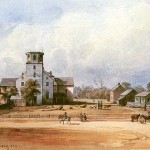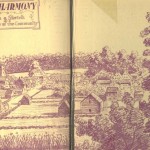When 19th-century social reformer Robert Owen and Indiana are mentioned together, the town of New Harmony immediately comes to mind.
Even though the settlement failed as a communal experiment, it became known for its famous inhabitants, including educational reformer William Maclure, naturalist Thomas Say, geologist Robert Dale Owen, and many others lured to the wilderness of frontier Indiana by Owen and his vision for the ideal society.
Owen’s ideal of communal living also inspired many other Americans in the early republic, including a number of settlers living in Van Buren Township, Monroe County, approximately seven miles southwest of the then-small town of Bloomington. In the spring of 1826, twenty-seven men and women signed a constitution to form an Owenite settlement located near Blue Spring.
From the information that can be gleaned from early land deeds, marriage and birth records, and local histories, these men and women were indistinguishable from their neighbors: nearly all were farmers (except for a mill owner and his millwright); almost all were married and many were part of extended families that also lived in the area; and many of the couples already owned land (anywhere from a relatively small 80-acre farm to a 320-acre half section).
The constitution they signed envisioned a cooperative that would live in shared housing, with farming and manufacturing that would eventually make the community self-sufficient. All the children would receive an excellent education, and all adult members would have a voice in the policies of the community and who would be accepted into the membership.
Like several other experimental Owenite communities that popped up along the East coast and on the midwestern frontier, the Blue Spring Community lasted a little more than one year. A group of cabins, a school, and a small store were apparently built – the men cooperated in farming common land and their own farms; the women were tasked with cooking, laundering, sewing, and other domestic chores for the community.
The group dispersed sometime in the spring or summer of 1827, broken apart by internal dissent. Unlike the beautiful buildings of New Harmony, which are visited by tens of thousands of tourists every year, the Blue Spring community has disappeared into farms, housing tracts, and other modern development.
A Moment of Indiana History is a production of WFIU Public Radio in partnership with the Indiana Public Broadcasting Stations. Research support comes from Indiana Magazine of History published by the Indiana University Department of History.
Source Article: Dawn Bakken, “‘A Full Supply of the Necessaries and Comforts of Life’: The Constitution of the Owenite Community of Blue Spring, Indiana,” Indiana Magazine of History, Volume 107, September 2011.





















